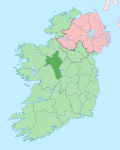Church and graveyard
It is said that Saint Patrick visited Fuerty and left a deacon to found a monastic settlement here. The deacon, Justus, baptised Saint Ciarán, a local man around the year 500. Ciaran went on to found Clonmacnoise, which became one of the most important monasteries and centres of learning in Europe. [2]
Two 8th century granite grave slabs in the west side of the tower bear inscriptions that can still be read. One of them bears the name of Ardeachan, Abbot of Clonmacnoise. The abbey was attacked and destroyed by the English Elizabethan invaders and all its monks were slain. Later, during the Cromwellian conquest of Ireland, it is claimed in a book by Skeffington Gibbon (published in 1829) that Cromwellian troops, under the leadership of Colonel (or Major) Ormsby, 'immolated' (i.e. killed by fire) more than one hundred elderly clergy at Fuerty abbey. [3] [4]
The existing ruins are of a 17th-century Church of Ireland. The tower was added in 1790 but the church was destroyed by fire in 1870.
This page is based on this
Wikipedia article Text is available under the
CC BY-SA 4.0 license; additional terms may apply.
Images, videos and audio are available under their respective licenses.


